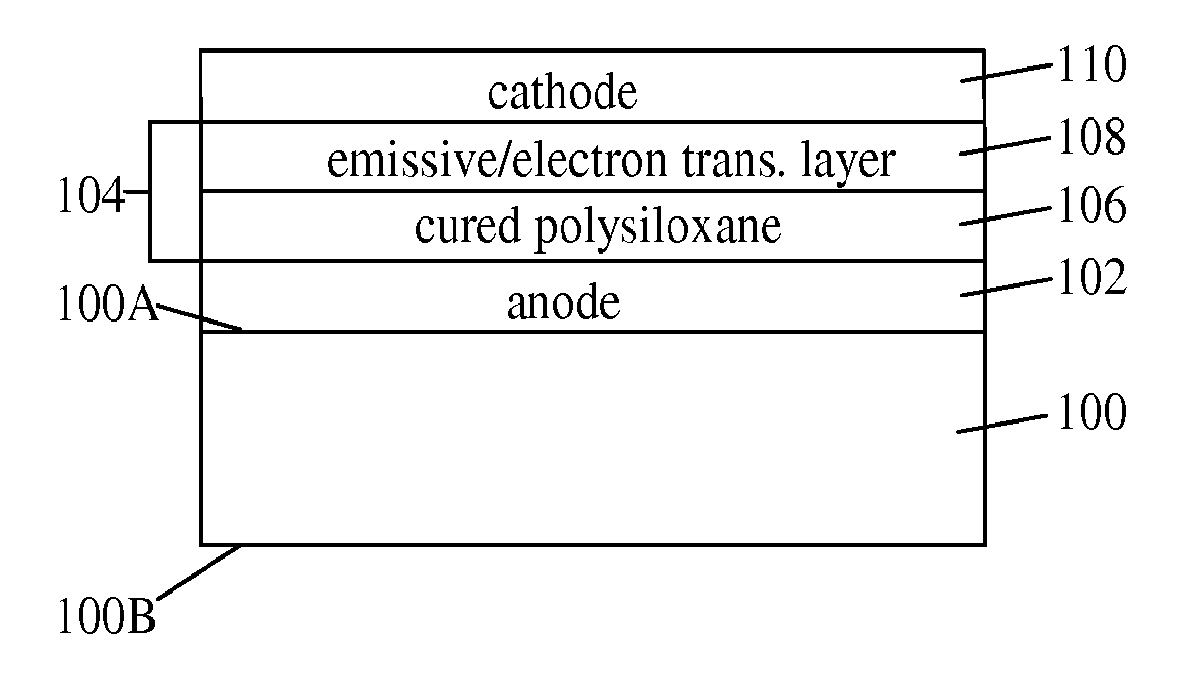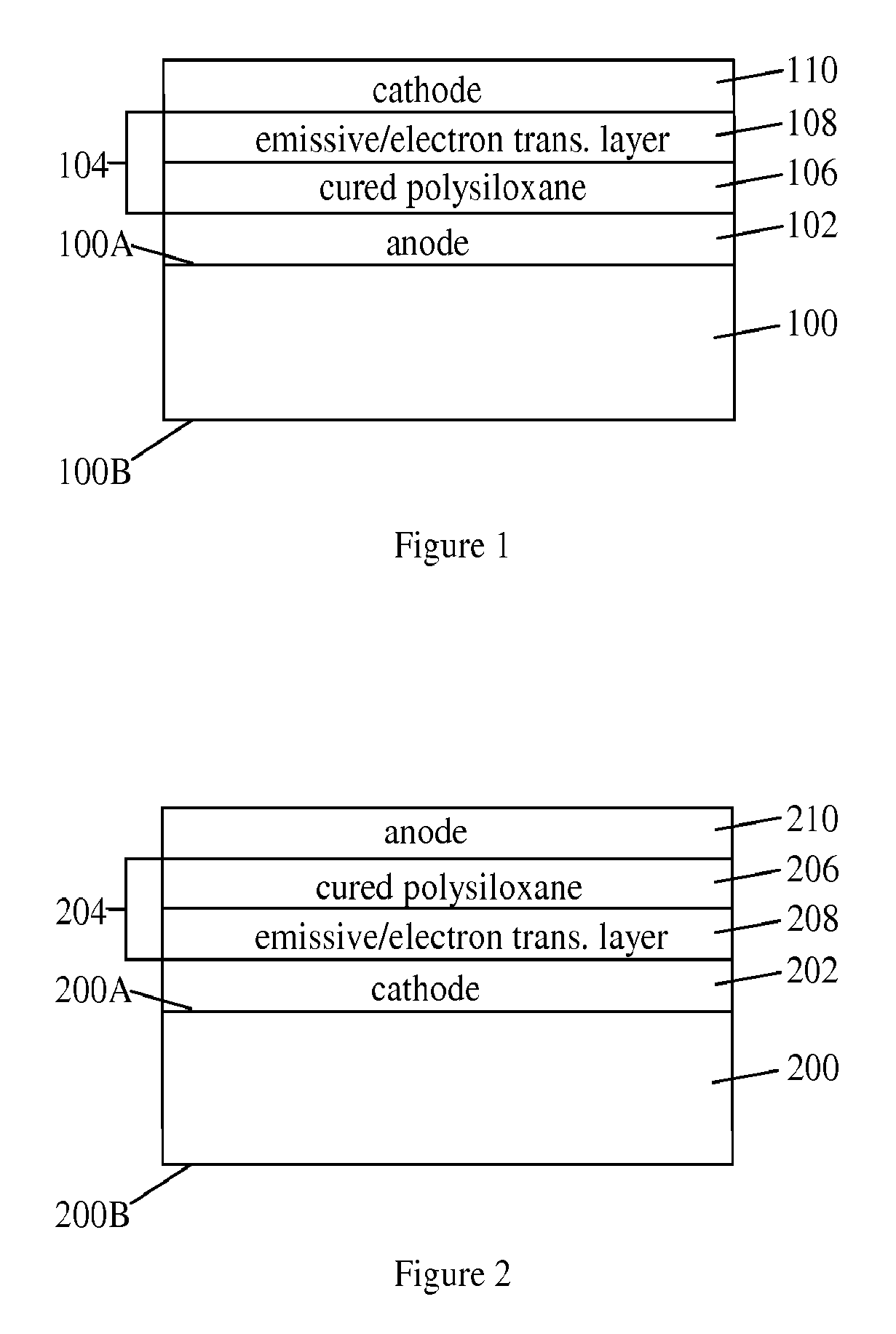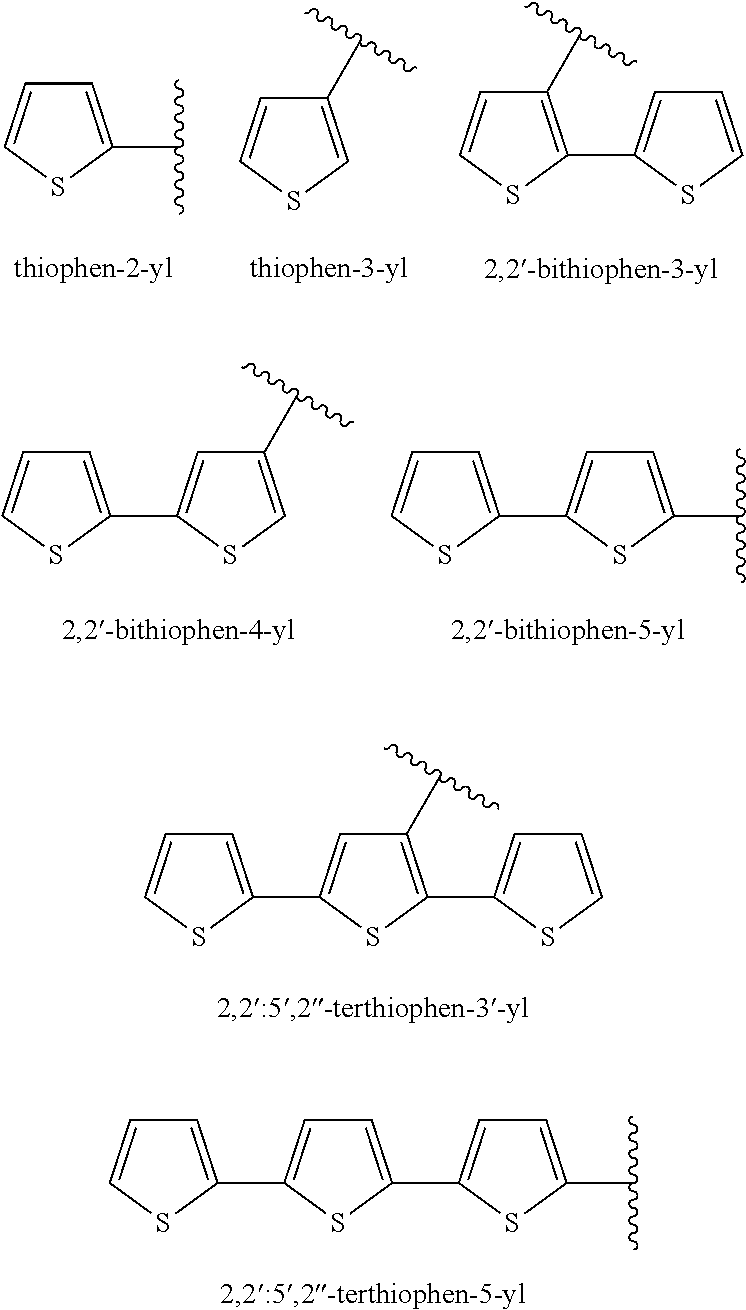Silicone composition and organic light-emitting diode
a light-emitting diode and organic technology, applied in the field of composition, can solve the problems of high acidity, high resistance to electrochemical reactions, and many limitations of the hole-transport layer comprising pdot:pss, and achieve the effects of low turn-on voltage, high brightness, and high transparency
- Summary
- Abstract
- Description
- Claims
- Application Information
AI Technical Summary
Benefits of technology
Problems solved by technology
Method used
Image
Examples
example 1
[0116]2-Allylthiophene (25 g), 13 g of anhydrous toluene (13 g), and 250 mg of Platinum Catalyst were combined under nitrogen in a three-neck flask equipped with a reflux condenser and a dropping funnel. Then, 30 g of trichlorosilane was added drop-wise to the mixture. Upon completion of the addition, the mixture was heated to 60° C. and maintained at that temperature for 2 h. Then, the mixture was distilled at 150° C. and 0.02 ton to give 2-(3-trichlorosilylpropyl)thiophene as a colorless liquid: 1H NMR (CDCl3) δ 7.16 (dd, 1H, J=5.1, 0.9 Hz); 6.95 (dd, 1H, J=4.8, 3.3 Hz); 6.83 (m, 1H); 2.96 (t, 2H, J=7.2 Hz); 1.98 (m, 2H); 1.46 (m, 2H).
[0117]2-(3-Trichlorosilylpropyl)thiophene (5.0 g) and 50 g of methyl isobutyl ketone were combined in a flask. Then, 400 mg of silicon tetrachloride and 430 mg of 1,8-bis(trichlorosilyl)octane were added to the solution. The resulting mixture was cooled at −78° C. for 1 h. Next, 10 g of water was added to the mixture during a period of 1 h. When the ...
example 2
[0118]The hydrosilylation reaction of Example 1 was repeated using 18.7 g of 5-allyl-2,2′-bithiophene in place of 2-allylthiophene, 10 g of anhydrous toluene, 20 g of trichlorosilane, and 150 mg of Platinum Catalyst. 5-(3-Trichlorosilylpropyl)-2,2′-bithiophene was obtained as a colorless liquid: 1H NMR (CDCl3) δ 7.20 (dd, 1H, J=5.1, 1.2 Hz); 7.14 (dd, 1H, J=3.6, 0.9 Hz); 7.02 (m, 2H); 6.74 (d, 1H, J=3.6 Hz); 2.93 (t, 2H, J=7.2 Hz); 1.99 (m, 2H); 1.49 (m, 2H).
[0119]The hydrolysis reaction of Example 1 was repeated using 5-(3-trichlorosilylpropyl)-2,2′-bithiophene in place of 2-(3-trichlorosilylpropyl)thiophene.
example 3
[0120]The hydrosilylation reaction of Example 1 was repeated using 4.5 g of 2-allyl-5-methylthiophene in place of 2-allylthiophene, 2.5 g of anhydrous toluene, 5.0 g of trichlorosilane, and 50 mg of Platinum Catalyst. 2-(3-Trichlorosilylpropyl)-5-methylthiophene was obtained as a colorless liquid: 1H NMR (CDCl3) δ 6.60 (m, 2H); 2.88 (t, 2H, J=7.2 Hz); 2.47 (s, 3H); 1.95 (m, 2H); 1.47 (m, 2H).
[0121]The hydrolysis reaction of Example 1 was repeated using 2-(3-trichlorosilylpropyl)-5-methylthiophene in place of 2-(3-trichlorosilylpropyl)thiophene.
PUM
| Property | Measurement | Unit |
|---|---|---|
| temperature | aaaaa | aaaaa |
| temperature | aaaaa | aaaaa |
| temperature | aaaaa | aaaaa |
Abstract
Description
Claims
Application Information
 Login to View More
Login to View More - R&D
- Intellectual Property
- Life Sciences
- Materials
- Tech Scout
- Unparalleled Data Quality
- Higher Quality Content
- 60% Fewer Hallucinations
Browse by: Latest US Patents, China's latest patents, Technical Efficacy Thesaurus, Application Domain, Technology Topic, Popular Technical Reports.
© 2025 PatSnap. All rights reserved.Legal|Privacy policy|Modern Slavery Act Transparency Statement|Sitemap|About US| Contact US: help@patsnap.com



